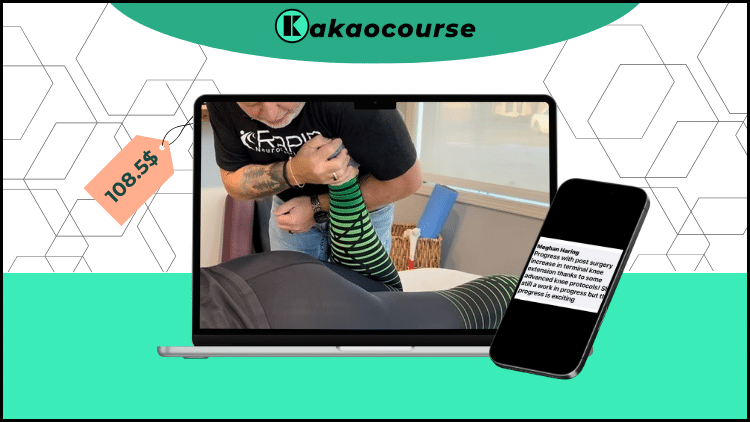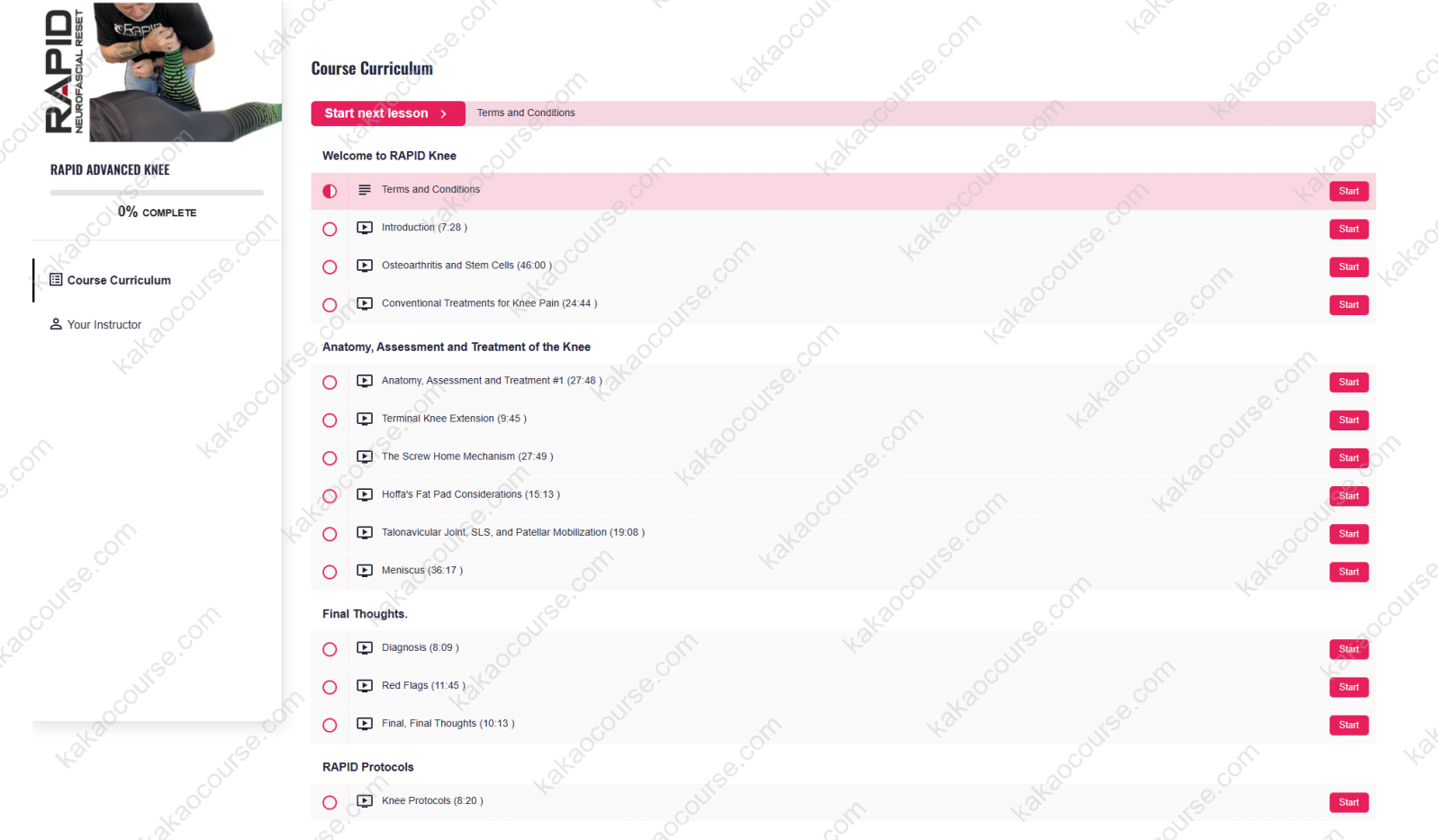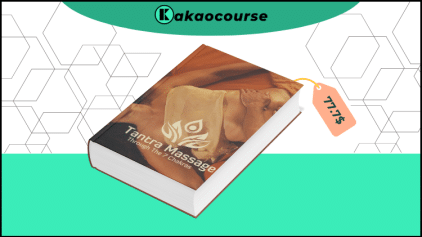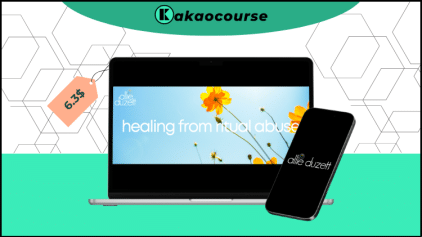Instant Download RAPID Advanced Knee Online by Rob and Sherry Routledge – Includes Verified Content:
RAPID Advanced Knee Online by Rob and Sherry Routledge, Check Out the Full Course Contents:
RAPID Advanced Knee Online by Rob and Sherry Routledge, Check Out This Free Video for Additional Information:
RAPID Advanced Knee Online by Rob and Sherry Routledge, Get Your Free PDF Sample Here:
Overview this course
RAPID Advanced Knee Online by Rob and Sherry Routledge is a specialized, graduate-level training built for clinicians who have completed the RAPID Lower Body course and are ready to master the knee with greater precision and confidence. This program moves beyond foundational protocols into the nuanced reasoning, hands-on decision pathways, and updated evidence you need to address complex knee presentations in real clinical settings.
Across a carefully structured curriculum, you will refine the way you observe, question, test, and treat. The emphasis is on clinical clarity—how to differentiate similar patterns, identify red flags early, and select the most effective intervention sequence for the patient in front of you. You will revisit core RAPID concepts through the lens of advanced knee work, study the neuro-myofascial relationships that influence function, and examine how recent findings—particularly around osteoarthritis and regenerative approaches—intersect with RAPID protocols.
Expect case-based learning, precise technique refinement, and an academic style that still feels practical and readable. If you want to elevate outcomes for knee pain, post-surgical presentations, sports injuries, or persistent movement limitations, this course is a direct route to higher-level practice. 🌍
Why should you choose this course?
-
Designed for graduates who want depth—not repetition: The content assumes you know the RAPID Lower Body fundamentals and focuses on what changes the most in real practice: sharper assessment, cleaner differential reasoning, and more targeted intervention mapping.
-
True “advanced” scope: From Hoffa’s fat pad to the screw-home mechanism and terminal knee extension, you will engage with structures and biomechanics that often go under-assessed yet drive stubborn symptoms.
-
Evidence-aware and clinically grounded: You will review up-to-date literature on osteoarthritis and explore where emerging modalities—such as stem-cell-related research—may intersect with RAPID methodology, always with a critical, clinically responsible stance.
-
Neuro-orthopedic integration: The course highlights nerves, ligaments, and connective tissues as a system—clarifying how neural sensitivity, fascial continuity, and capsuloligamentous restraint shape both pain and performance.
-
Protocol refinement: You’ll revisit RAPID knee sequences from the Lower Body course and learn how to adapt, layer, or reorder them when variables shift (co-morbidities, surgical history, training load, fatigue, psychosocial context).
-
Outcome-oriented thinking: By examining contemporary data on conventional treatments and surgery outcomes, you’ll be better equipped to set expectations, communicate options, and track progress with clarity.
-
Taught by recognized educators: Rob and Sherry Routledge bring a rigorous, practiced approach to teaching advanced techniques while keeping the learning curve accessible and engaging.
-
100% online access: Learn wherever you are, pace your study to your schedule, and revisit complex segments as often as needed. 💻
What You’ll Learn
Advanced Diagnostic Techniques
-
Structured knee assessment that combines observation, palpation, and movement analysis into a single, repeatable workflow.
-
Practical differential diagnosis: distinguishing articular vs. peri-articular contributors; when symptoms reflect neural mechanosensitivity vs. local tissue overload.
-
Red-flag recognition: how to screen for systemic or urgent issues that require referral—without over- or under-referring.
-
Decision trees for complex cases (e.g., conflicting test results, variable irritability, multi-site pain) so your next step is always intentional.
In-Depth Anatomical Study
-
A layered view of the knee: articular cartilage, menisci, cruciates, collaterals, retinacula, and the role of the posterior capsule.
-
Neural interfaces (saphenous, tibial, peroneal branches) and why neural mobility and sensitivity modulate knee symptoms and load tolerance.
-
Connective-tissue and fascial continuities linking the hip, knee, and ankle—practical implications for load distribution and symptom referral.
-
Application to RAPID: how anatomical knowledge informs palpation lines, hand positioning, graded exposure, and the sequencing of techniques.
Latest Research Insights
-
Osteoarthritis: contemporary views on pathophysiology, load management, and symptom modulation; what “degeneration” means functionally vs. radiographically.
-
Emerging stem-cell literature: where the research stands, what it suggests, and how to integrate this knowledge responsibly into patient education and RAPID planning.
-
Translating evidence to action: aligning your technique choice, dosing, and progression with study insights—without losing individualization.
Specialized Treatment Strategies
-
Hoffa’s fat pad (infrapatellar fat pad): assessment cues, aggravating positions, precision palpation, and technique selections that respect irritability.
-
Screw-home mechanism: why terminal tibiofemoral rotation affects stability, tracking, and perceived stiffness; assessment drills you can implement immediately.
-
Terminal knee extension (TKE): restoring end-range without provoking symptoms—combining manual inputs, neuromuscular re-education, and graded loading.
-
Integrating proximal and distal contributors (hip rotation control, foot pronation/supination mechanics) to improve knee behavior under load.
Revised RAPID Protocols—Advanced Application
-
A systematic review of Lower Body knee treatments with modifications for different irritability levels and presentation types.
-
Alternative routes when a standard sequence stalls: altering vectors, dosage, patient position, or the order of interventions.
-
Progression frameworks: moving from symptom change to function change to capacity change, with checkpoints and re-tests that keep you honest.
Conventional Treatments and Outcomes—Critical Appraisal
-
What current datasets and reports indicate about common surgical and non-surgical pathways.
-
Communicating relative benefits and limitations to patients in a balanced, non-alarmist way.
-
Incorporating outcome literacy into shared decision-making and long-term planning.
Clinical Communication & Documentation
-
Crisp, patient-friendly language to explain mechanisms (e.g., why the knee pinches in terminal extension, or why fat pad irritability flares after prolonged standing).
-
Documentation that links assessment findings to chosen techniques, making your clinical reasoning visible and defensible.
-
Progress tracking: selecting metrics that matter—pain behavior, function under load, movement confidence—rather than chasing numbers without context.
Ethics, Safety, and Scope
-
Knowing the edges of your practice: when to collaborate, when to refer, and how to keep safety central while still pursuing meaningful change.
-
Respectful, culturally aware communication for global patient populations.
-
Bias checks in clinical reasoning—guarding against confirmation bias and outcome bias in fast-paced practice.
Who Should Take This Course?
-
Graduates of the RAPID Lower Body course who want to specialize in knee care and sharpen their advanced assessment and treatment decision-making.
-
Manual therapists, bodyworkers, massage therapists, athletic therapists, and movement professionals seeking a rigorous framework for complex knee presentations.
-
Rehab and performance practitioners who regularly encounter knee pain, post-operative restrictions, or sport-specific limitations in extension, rotation, or load tolerance.
-
Clinicians in multidisciplinary settings who must communicate clearly about options, risks, and expected timelines with patients and colleagues.
-
Experienced practitioners mentoring others, looking for a common language and repeatable system to teach clinical reasoning and technique sequencing.
Prerequisite: Completion of RAPID Lower Body. This ensures a shared foundation so we can dive directly into advanced material.
Conclusion
The knee is simple in concept and intricate in reality. Subtle shifts—a slightly sensitized fat pad, a missing few degrees of terminal extension, an overlooked neural tether—can keep progress stalled for months. RAPID Advanced Knee Online by Rob and Sherry Routledge equips you to see those subtleties, test them efficiently, and intervene with precision. You will learn to connect anatomy to behavior, evidence to action, and protocol to person—so the right input happens at the right time, for the right reason.
By the end, you will:
-
Read the knee with a differential eye, recognizing when a finding is meaningful and when it is simply present.
-
Navigate conflicting signs with structured decision trees, so your plan remains coherent under uncertainty.
-
Modify RAPID protocols responsively—scaling pressure, changing vectors, or repositioning to respect irritability while still driving adaptation.
-
Communicate options with calm authority, informed by current data on conventional treatments and surgeries.
-
Document clearly, track meaningful outcomes, and hold yourself accountable to functional change—not just transient symptom shifts.
If your goal is to move beyond “general lower body work” and add elite-level knee reasoning and technique to your practice, this course offers a direct, academically robust path.











Reviews
There are no reviews yet.